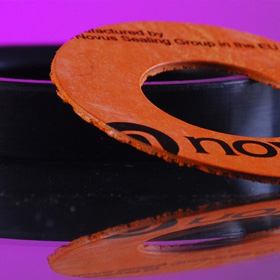
Gasket design can’t be limited by a generic shape, not when flange outlines muddy the waters by diverging in form. There are currently three common faces that require specialised flange face gaskets, of which we’ll begin with the basic flat faces family. After chronicling the planar profile, we’ll hop across to raised face flanges. Finally, we’ll conclude with ring-type joint faces.
Common Flat Faces Dominate Flange Design
In order to strengthen the seal between two fluid-conveying mechanical sections, shaped flanges must be partnered with matching flange face gaskets, the reinforced rings that support the uniquely contoured surfaces of the joint-strengthening mechanical asset. A flattened flange adopts a planar form so that the bolt ring and contact zone are on the same level. The gasket is seated flush against these interior plate sections, thus ensuring the flange mates evenly.
Raised Face Flanges Deliver Concentrated Contact Force
When the gasket area is machined so that it’s raised above the bolt circle, then compressible force is focused on that contact area. This feature enables a diverse range of gasket types to be employed within this reduced cross-sectional area. They include spiral wound and double jacketed gaskets, sealing types that function best when used in chemical processing plants and highly toxic production facilities. Mated raised face flanges are easy to identify because an initial glance fools an observer into believing a gap exists between the faces. A closer look reveals the ring of bolts surrounding the contact area while the external edges of the flanges are spatially free but subject to enhanced fastener compression.
Ring-Type Joint Faces
Called into service when specialised sealing applications arise, this flange type uses a proprietary oval and octagonal configuration, a groove surface contact area that requires the two facing surfaces to wedge together and create a tightly secured joint. Used in high-temperature and high-pressure industrial scenarios, the flanges are finely machined to guarantee initial line contact, so the accompanying gasket is also made from an alloy-reinforced material. In doing so, the mating surfaces wedge together in such a way as to generate a “microfine” joint. In effect, the soft metals weld together.
In flange engineering terms, flat faces are workhorse products, the full-contact champions that dominate most applications, but flange face gaskets don’t always favour a broad cross-sectional areal format, which is when ring-type joint faces and their ilk take over by focusing fastener pressure on a reduced contact zone, an area that requires metal gaskets and robust seals.
If flanges mechanically fasten sections of pipe together, traditionally by employing sets of stubby bolts, then gaskets are the leak-guarding inserts that make sure the two mating surfaces are fluid-proof. Of course, secure as this fastening configuration is, we’re still looking at discrete parts, and isolated parts are leak-susceptible. Let’s reinforce our understanding of this surface-mating action by taking a look at the common causes of gasket failure so that we can deliver a pipeline that’s guaranteed to remain leak free over its entire processing life.
The Common Causes of Gasket Failure Include
We begin with the characteristics of the conveyed fluid. A chemically active facility processes caustic materials. Condensed and distilled until the substance is extremely corrosive, poorly manufactured gaskets will deteriorate and eventually succumb to wear, thus allowing the fluid to seep through the damaged gasket. The same potential for failure exists in scenarios where high pressures and higher temperatures imbue the fluid with unprecedented amounts of energy.
Mechanically-Induced Leakage Events
System vibrations are generated by machinery. Resonating tremors are mechanically transmitted along metal frameworks and pipes. The result is a slackening action, a scenario where once secure nuts and bolts loosen. The tight union between the two flange surfaces gives way, perhaps imperceptibly, until gasket compression is lost and the seal springs a leak. The thermal events covered above also contribute system-detrimental effects, with metal parts expanding and contracting until, again, the flange fasteners slacken.
Avoid Unintelligent Installation Practices
This situation introduces elements from both of the paragraphs covered above. Material science has intelligently manufactured a wide range of polymer-reinforced gaskets, but this means the right material has to be paired with the right application. A chemically resistant material interfaces with a chemical processing plant, a heatproof variant is installed in a heat exchanger assembly, and so on. If the wrong product is installed, expect trouble. The same case applies in mechanically-dominant settings. If the two flanges don’t properly align, for example, then loading is applied unequally and the gasket isn’t uniformly compressed, which opens the joint to a potentially devastating leakage event.
The common causes of gasket failure are many, but, once evaluated, we can quickly incorporate safeguards. The flanges and the fasteners are engineered to eliminate the majority of surface flaws, even the intrusion of corrosion due to cathodic effects. Then, upon proper installation, our final responsibility is to insert geometrical-assured outlines that are material-assessed to ensure they fit their application.